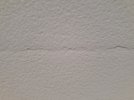I'm wondering if anyone can help with this. I've removed popcorn from several the ceilings in our house. Once removed, it appears the tape job most likely wasn't up to fully finished standards for painting. I guess because of the popcorn being sprayed on. So I've gone over the joints between the seams and the ceiling/wall junction with USG Plus 3 compound prior to painting the ceilings. Two coats with sanding in between and after.
This has worked very well everywhere but the kitchen ceiling. In that location after about 1 year I'm noticing a slight bulge in the tape lines between the joints running the width of the ceiling. It's not really visible because the Ultra White ceiling paint hides it very well. I'm just concerned that I may have done something to cause it and don't want to repeat any mistake I may have made. I also don't know if eventually it's going to crack.
I'm wondering if you folks might have the answer to this? Thanks very much for any help you can give me.

This has worked very well everywhere but the kitchen ceiling. In that location after about 1 year I'm noticing a slight bulge in the tape lines between the joints running the width of the ceiling. It's not really visible because the Ultra White ceiling paint hides it very well. I'm just concerned that I may have done something to cause it and don't want to repeat any mistake I may have made. I also don't know if eventually it's going to crack.
I'm wondering if you folks might have the answer to this? Thanks very much for any help you can give me.

